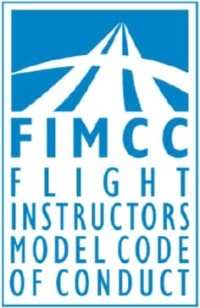Recommended Best Practices Designed To Improve Flight
Instruction Experience
 The Flight Instructors Model Code of Conduct (FIMCC) was
released Monday by the project’s Permanent Editorial Board.
Developed by a team of aviation professionals and drawing upon
decades of research and experience, the Code recommends operating
practices designed to improve the quality of flight instruction and
the safety of flight training operations.
The Flight Instructors Model Code of Conduct (FIMCC) was
released Monday by the project’s Permanent Editorial Board.
Developed by a team of aviation professionals and drawing upon
decades of research and experience, the Code recommends operating
practices designed to improve the quality of flight instruction and
the safety of flight training operations.
"It is an outstanding document that belongs in every
instructor's flight kit," said Barry Schiff, retired airline
captain and regular columnist for AOPA Pilot magazine. His
colleague Rod Machado added "If a flight instructor follows even a
few of these principles, he or she will be a much better
person for it. Those that use the model code of conduct to help
align their moral compass will make significant contributions to
our industry."
A professional code can help users achieve new levels of
proficiency, and the FIMCC represents a set of guidelines that is
adaptable to each flight training organization and flight
instructor.
According to the editorial board, the FIMCC:
- Promotes flight and ground instructor safety, professionalism,
and instructor contributions to the aviation community and society
at large.
- Encourages the development and adoption of good judgment,
ethical behavior, and personal responsibility.
- Supports improved communications between instructors, students,
regulators, and others in the aviation industry.
- Promotes recognition of instruction as a highly respected and
rewarding profession.
The FIMCC is designed for flight instructors at all levels from
light sport to instrument, multiengine at large flight schools or
as independent operators. Most pilots look to flight instructors as
experts. The manner in which instructors teach and the examples
they set impact the safety culture of aviation. The Code of Conduct
will help instructors serve as role models for the entire aviation
community.
The Code of Conduct received extensive industry review and
presents a vision of flight training excellence within its seven
sections: (1) General Responsibilities of Instructors; (2)
Students, Passengers, and People on the Surface; (3) Training and
Proficiency; (4) Security; (5) Environmental Issues; (6) Use of
Technology; and (7) Advancement and Promotion of Aviation
Instruction. The Code of Conduct is a living document and will be
periodically updated to reflect changes in standards, practice, and
the aviation environment.
"I think if you can get this widely distributed into the
aviation education community and get CFIs to heed the advice, it
would go a long way toward improving the overall flight instruction
experience, particularly for primary students who are just starting
out and gaining their first impression of general aviation," said
AOPA Air Safety Institute Director of Safety and Chief Flight
Instructor, JJ Greenway.
The Flight Instructors Model Code of Conduct is the latest in a
family of similar codes including the Aviation Maintenance
Technicians Model Code of Conduct, the Aviators Model Code of
Conduct, the Glider Aviators Model Code of Conduct, the Light Sport
Aviators Model Code of Conduct, the Seaplane Pilots Model Code of
Conduct, and the Student Pilot Model Code of Conduct. Each is
available online as a free public service along with supporting
materials.
 ANN's Daily Aero-Term (05.17.24): Very High Frequency
ANN's Daily Aero-Term (05.17.24): Very High Frequency ANN's Daily Aero-Linx (05.17.24)
ANN's Daily Aero-Linx (05.17.24) ANN FAQ: Submit a News Story!
ANN FAQ: Submit a News Story! Classic Aero-TV: ANN Visits Wings Over The Rockies Exploration Of Flight
Classic Aero-TV: ANN Visits Wings Over The Rockies Exploration Of Flight Airborne Affordable Flyers 05.16.24: PRA Runway, Wag-Aero Sold, Young Eagles
Airborne Affordable Flyers 05.16.24: PRA Runway, Wag-Aero Sold, Young Eagles



